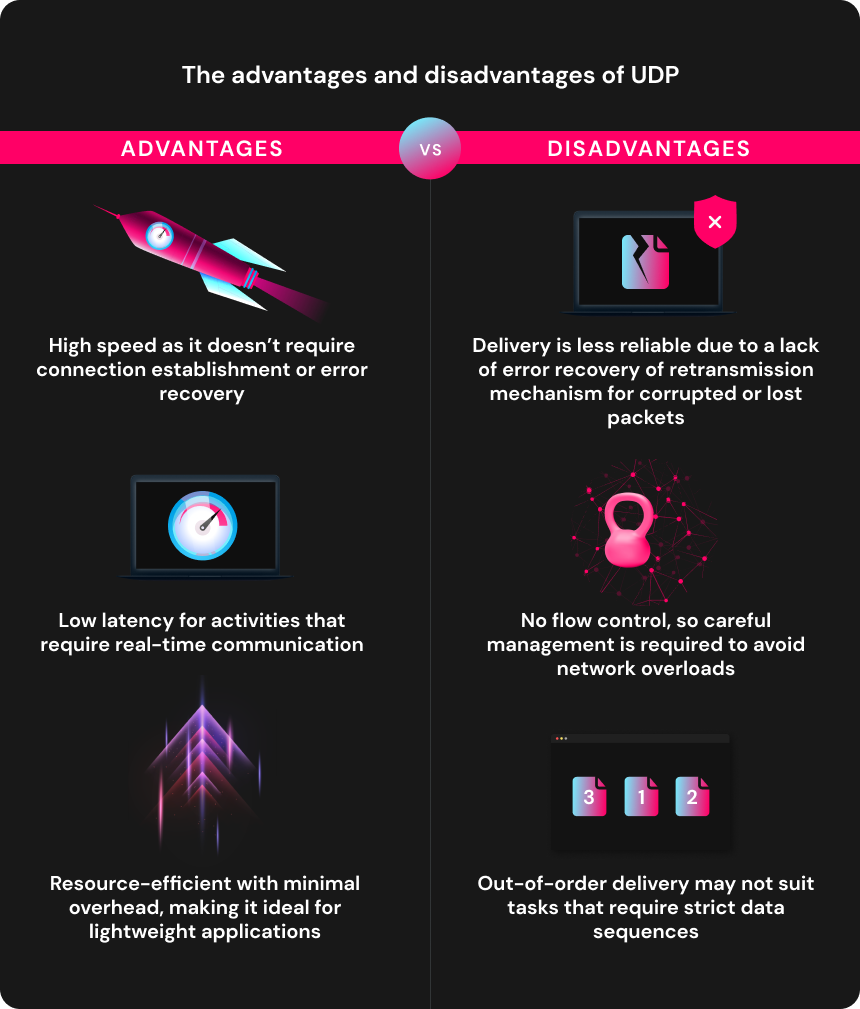User Datagram Protocol, or UDP, is a standard communication protocol in the Internet Protocol suite. UDP works at the transport layer of the OSI (Open Systems Interconnection) communications model, facilitating the transmission of data between devices on a network.
How and when is UDP used?
UDP is most typically used in instances when speed takes priority over accuracy and reliability in data transmission. As such, the protocol’s common uses include:
- Real-time apps: Applications that rely on real-time user inputs, such as communications, live-streaming, or gaming apps, require high speed and low latency in data transmission, so they typically rely on UDP.
- DNS queries: DNS (Domain Name System), which converts a domain name to an IP address, utilizes UDP for DNS queries. As queries typically involve a single request, they benefit from the speed of UDP.
- Broadcasting: As UDP allows quick and easy data transmission to large groups of recipients without establishing individual connections, it is ideal for broadcasting.
- IoT: The Internet of Things (IoT) relies on UDP to allow enabled devices to exchange small data packets with minimal latency rapidly.
How does UDP differ from TCP?
UDP and TCP (Transmission Control Protocol) are two transport layer communication standards. While they perform a similar function in facilitating communication between network devices, they also differ in some key ways:
- Connection: UDP is what is known as a connectionless protocol, meaning that it can facilitate data transmission without needing to establish a dedicated connection. TDP, on the other hand, is a connection-oriented protocol that must establish a reliable, two-way connection for communication before data transmission can commence.
- Error handling: With UDP, data packets are transmitted without making provisions for errors in order to achieve maximum efficiency. Conversely, TCP includes error-checking, correction, and retransmission mechanisms to ensure maximum accuracy.
- Delivery order: UDP does not insist on a particular delivery order, meaning that packets will arrive in the order that is fastest, rather than in the order that they were sent. With TCP, packets are always sent in order for accuracy.
What are the advantages and disadvantages of UDP?
There are both advantages and disadvantages to TCP:
Advantages
- High speed as it doesn’t require connection establishment or error recovery
- Low latency for activities that require real-time communication
- resource-efficient with minimal overhead, making it ideal for lightweight applications
Disadvantages
- Delivery is less reliable due to a lack of error recovery of retransmission mechanism for corrupted or lost packets
- No flow control, so careful management is required to avoid network overloads
- Out-of-order delivery may not suit tasks that require strict data sequences

Conclusion
To conclude, UDP is a connectionless communication protocol that facilitates rapid data transmission. Its lack of error recovery, retransmission, and flow-control mechanisms means that UDP is less reliable for tasks like email or remote access, however, the protocol’s low overhead gives it the advantage in terms of speed and latency, making it well-suited for unidirectional communication and lightweight applications requiring real-time transmission.

